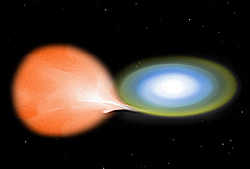
A nova is a transient astronomical event that causes the sudden appearance of a bright, apparently "new" star that slowly fades over weeks or months. Causes of the dramatic appearance of a nova vary, depending on the circumstances of the two progenitor stars. All observed novae involve white dwarfs in close binary systems. The main sub-classes of novae are classical novae, recurrent novae (RNe), and dwarf novae. They are all considered to be cataclysmic variable stars.

Sagittarius is one of the constellations of the zodiac and is located in the Southern celestial hemisphere. It is one of the 48 constellations listed by the 2nd-century astronomer Ptolemy and remains one of the 88 modern constellations. Its old astronomical symbol is (♐︎). Its name is Latin for "archer". Sagittarius is commonly represented as a centaur drawing a bow. It lies between Scorpius and Ophiuchus to the west and Capricornus and Microscopium to the east.

V606 Aquilae was a nova, which lit up in the constellation Aquila in 1899. The brightest reported magnitude for this nova was apparent magnitude 5.5, making it a naked eye object. It was discovered by Williamina Fleming on a photographic plate taken on 21 April 1899 at the Harvard College Observatory. On the discovery plate, its photographic magnitude was later determined to be 6.75. It was not seen on the plate taken on 1 November 1898, and there were no reported observations of the region around the star during the 171 day interval before Fleming's discovery, so it is possible that the actual maximum of the event was missed. By 27 October 1899 it had faded to 10th magnitude, and on 9 July 1900 Oliver Wendell reported its brightness to be between magnitude 11.5 and 12.0.

V1280 Scorpii is the first of two novae that occurred in the constellation Scorpius during February 2007. Announced by the IAU in Electronic Telegram No. 835 and Circular No. 8803, the nova's magnitude was 9.6 when it was discovered on CCD images taken at 20:42 UT on 4 February 2007 by Yuji Nakamura of Kameyama, Mie, Japan. It was independently discovered on the same night at 20:30 UT by Yukio Sakurai of Mito, Ibaraki, Japan. It peaked at magnitude 3.79 on February 17, making it easily visible to the naked eye. V1280 Scorpii is two degrees south of M62.

A luminous red nova is a stellar explosion thought to be caused by the merging of two stars. They are characterised by a distinct red colour, and a light curve that fades slowly with resurgent brightness in the infrared. Luminous red novae are not related to standard novae, which are explosions that occur on the surface of white dwarf stars.
VX Sagittarii is an extreme asymptotic giant branch star located more than 1.5 kiloparsec away from the Sun in the constellation of Sagittarius. It is a pulsating variable star with an unusually large magnitude range. It is also one of the largest stars discovered so far, with a radius varying between 1,350 and 1,940 solar radii (940,000,000 and 1.35×109 km; 6.3 and 9.0 au). It is the most luminous known AGB star, at bolometric magnitude –8.6, which is even brighter than the theoretical limit at –8.0.
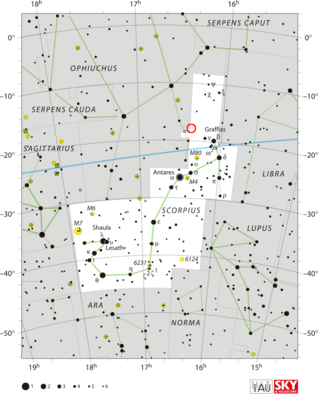
U Scorpii is a recurrent nova system; one of 10 known recurring novae in the Milky Way galaxy. Located near the northern edge of the constellation Scorpius it normally has a magnitude of 18, but reaches a magnitude of about 8 during outbursts. Outbursts have been observed in 1863, 1906, 1936, 1979, 1987, 1999, 2010, and 2022.
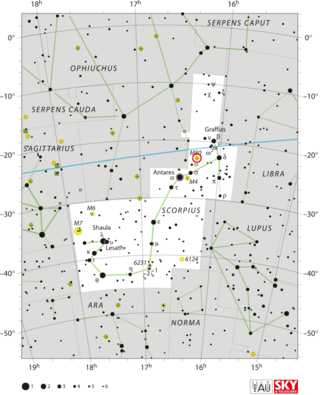
T Scorpii, or Nova Scorpii 1860, was a nova in the globular cluster Messier 80 (M80). It was discovered on 21 May 1860 by Arthur von Auwers at Koenigsberg Observatory and was independently discovered by Norman Pogson on May 28 at Hartwell observatory. It was at magnitude 7.5 at discovery, reaching a maximum of magnitude 6.8, outshining the whole cluster.

V1369 Centauri also known as Nova Centauri 2013 was a bright nova in the constellation Centaurus that occurred in 2013. It was discovered on December 2, 2013 by amateur astronomer John Seach in Australia with a magnitude of 5.5. On December 14, 2013 it peaked at about magnitude 3.3, making it the brightest nova so far of this millennium.
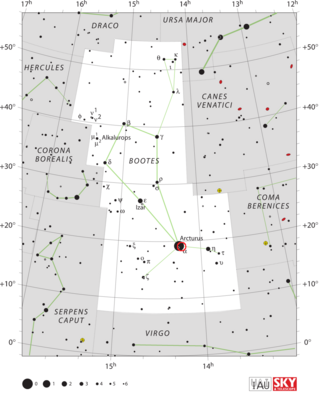
T Boötis is believed to have been a nova. It was observed by only one person, Joseph Baxendell on 9, 11 and 22 April 1860, but has not been seen since. It is located less than half a degree from Arcturus in the constellation Boötes and was at magnitude 9.75 when first seen, and magnitude 12.8 when last seen. Other astronomers, including Friedrich Winnecke, Edward Charles Pickering, Ernst Hartwig and Ernst Zinner looked for a star in this location without success.

V5856 Sagittarii, also known as Nova Sagittarii 2016 Number 4, was the 4th and brightest nova that occurred in the constellation Sagittarius during 2016. It was discovered by the All Sky Automated Survey for SuperNovae on 25.02 October 2016, at which time it had an apparent visual magnitude of 13.7. It was independently discovered by Yukio Sakurai of Mito, Ibaraki, Japan on 26.38 October 2016, by which time it had reached magnitude 10.4. It reached its peak brightness of magnitude 5.4, making it visible to the naked eye, on 8 November 2016. The nova occurred within a region of the sky monitored by the OGLE microlensing experiment, and that group reported that no star brighter than magnitude 22 was seen at the nova's position prior to its eruption.

V5668 Sagittarii, also known as Nova Sagittarii 2015 Number 2 was the second and brighter of two novae in the southern constellation of Sagittarius in 2015. It was discovered by John Seach of Chatsworth Island, New South Wales, Australia on 15 March 2015 with a DSLR patrol camera. At the time of discovery it was a 6th magnitude star. It peaked at magnitude of 4.32 on March 21, 2015, making it easily visible to the naked eye.
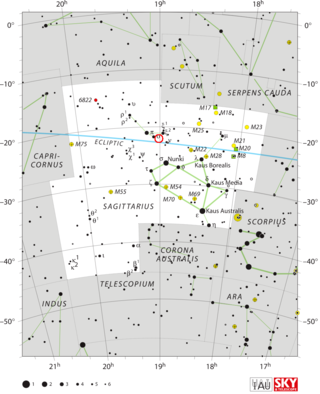
V4743 Sagittarii was a bright nova in the southern constellation of Sagittarius. This event was discovered by K. Haseda and colleagues in September 2002. It peaked at magnitude 5.0 on September 20, 2002, then declined rapidly thereafter. It reached a peak temperature of 740,000 K around April 2003 and remained at that level for at least five months, suggesting the white dwarf component has a mass of 1.1–1.2 M☉. The distance to this system is uncertain. Infrared observations indicate a distance of approximately 21 kly (6.3 kpc). A derivation using maximum magnitude rate of decay showed a distance of 12.7 ± 1.0 kly (3.9 ± 0.3 kpc).
V1309 Scorpii is a contact binary that merged into a single star in 2008 in a process known as a luminous red nova. It was the first star to provide conclusive evidence that contact binary systems end their evolution in a stellar merger. Its similarities to V838 Monocerotis and V4332 Sagittarii allowed scientists to identify these stars as merged contact binaries as well.

V357 Muscae was a bright nova in the constellation Musca. It was discovered on January 14, 2018 by Rob Kaufman of Bright, Victoria, Australia with a magnitude of 7.0.

YZ Reticuli, also known as Nova Reticuli 2020 was a naked eye nova in the constellation Reticulum discovered on July 15, 2020. Previously it was known as a VY Sculptoris type object with the designation MGAB-V207.

V630 Sagittarii was a nova visible to the naked eye in 1936. It was discovered on 3 October 1936 by Shigeki Okabayashi of Kobe, Japan when it had an apparent magnitude of 4.5.

FM Circini, also known as Nova Circini 2018, was a nova which appeared in the constellation Circinus in 2018. It was discovered by John Search of Chatsworth Island, New South Wales, Australia on 19.708 January 2018, using a DSLR with a 50 mm F/1.2 lens. At the time of its discovery, it had an apparent visual magnitude of 9.1. It was confirmed to be a nova spectroscopically on 21 January 2018. FM Circini reached a peak brightness of magnitude 5.8 on 22 March 2018, making it visible to the naked eye.
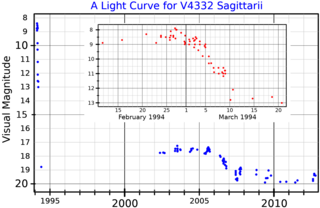
V4332 Sagittarii is a nova-like event in the constellation of Sagittarius. It was discovered February 24, 1994 at an apparent visual magnitude of 8.9 by Japanese amateur astronomer Minoru Yamamoto from Okazaki, Aichi, then confirmed by K. Hirosawa. Initially designated Nova Sagittarii 1994 #1, it was given the variable star designation V4332 Sgr. A spectra of the event taken March 4 lacked the characteristic features of a classical nova, with the only emission lines being of the Balmer series. Subsequent spectra showed a rapid decline in luminosity and a change of spectral type over a period of five days. By 2003, the object was ~1500 times less luminous than at peak magnitude and showed a spectrum of an M-type star.

















